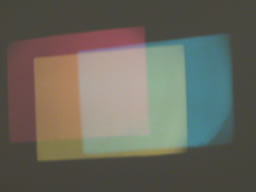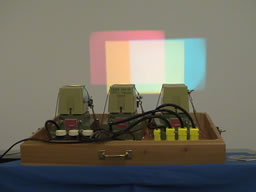Demos: 7C-01 Color by Addition


Directions: Three slide projectors are mounted side by side in a box. Dim the room lights, turn on each projector and adjust the focus so that three three sharp squares almost completely overlap on the screen. (By not having complete overlap, the individual colors can still be seen at the edges.)
Turn off the projectors and insert the blue, green and red filters. Turn on the projectors one at a time to show each of the primary colors individually. Then turn on two at a time to show the combinations RB, BG and RG. Do the combinations in that order. Then turn on all three to show white light. (You might have to adjust the intensities to get the best white.)
Note: A pole with a cardboard mask is available so that this same combination of colors can be viewed using the ceiling video projector. Simply move the mask around to cover the different lenses one at a time or two at a time to get the desired effect. Discuss this with the lec-demo technician.
Suggestions for Presentation: Students have difficulty accepting that Red, Green and Blue are the primary colors. These are the “additive primaries,” sometimes called the “eye primaries.”* They are the colors used in the phosphors of color television and computer monitors (see overhead available with this demo). Point out that the RYB combination they have been taught is basically the paints and dyes primaries, which follow basically the filter, or subtractive rules. The combinations RB (magenta), BG (cyan) and RG (yellow) are often referred to as secondary colors. They are also referred to as the subtractive primaries (see Demo 7C - 03)
*Note: Should you wish to delve a little deeper into this, an excellent demonstration is the following: Place an opaque card having a narrow slot on the stage of the overhead projector. Focus the slot on the screen. Then tape a holographic diffraction grating in front of the projection lens. A beautiful, bright white light spectrum will appear on the screen. Point out that the three major areas of color evident are red, green and blue. Indeed, the three types of cones in the eye are responsive to these three broad wavelengths, typically called red, green and blue.
Applications: Color television, computer monitors.
Last Updated: Nov 30, 2023 11:25 AM